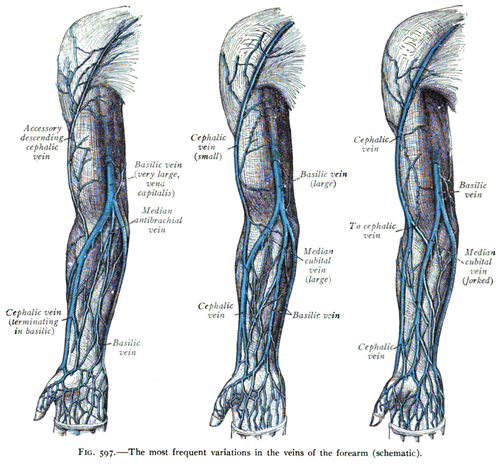Cephalic vein

Editor-In-Chief: Prab R Tumpati, MD
Obesity, Sleep & Internal medicine
Founder, WikiMD Wellnesspedia &
W8MD medical weight loss NYC and sleep center NYC

Cephalic Vein[edit]
In human anatomy, the cephalic vein (Latin: vena cephalica) is a prominent superficial vein of the upper limb, located along the anterolateral aspect of the arm. It is a key structure involved in superficial venous return from the hand and forearm and is often used clinically for venipuncture, intravenous therapy, and pacemaker lead insertion.
Anatomical Course[edit]
The cephalic vein originates from the dorsal venous network of the hand, specifically on the radial (thumb) side of the wrist. It ascends along the:
- Lateral forearm, passing over the radius and deep to the skin within the superficial fascia
- Anterior surface of the biceps brachii muscle, where it is often clearly visible beneath the skin
At the level of the cubital fossa, the cephalic vein communicates with the basilic vein via the prominent median cubital vein, which is a common site for venipuncture.
It then continues superiorly through the deltopectoral groove, the interval between the deltoid muscle and pectoralis major, and pierces the clavipectoral fascia within the deltopectoral triangle. From there, it empties into the deep venous system via the axillary vein.
Anatomical Relations and Variations[edit]
- The cephalic vein lies in close proximity to the cephalic artery (when present) and the lateral cutaneous nerve of the forearm
- Its location is superficial and consistent, making it ideal for cannulation
- The diameter, course, and communications of the vein may vary among individuals
Clinical Significance[edit]
The cephalic vein is frequently used in:
- Intravenous access, especially when veins in the antecubital fossa are not usable
- Placement of large-bore cannulae or peripherally inserted central catheters (PICC lines)
- Insertion of permanent pacemaker leads through the deltopectoral groove
Due to its accessibility and visibility, the cephalic vein is nicknamed the "Houseman's Friend"—a reference to its use by medical trainees for venous cannulation.
Etymology[edit]
The term "cephalic" typically pertains to the head. However, in this context, the usage is a result of a translation error. When the Arabic term al-kífal (meaning "outer") from Avicenna’s Canon of Medicine was translated into medieval Latin, it was mistakenly rendered as cephalicus, implying an incorrect association with the head.
Additional Images[edit]
-
Cross-section through the middle of the forearm showing superficial and deep veins
-
Superficial veins on the dorsum of the hand
-
Deep veins of the upper extremity
-
Cross-section of the upper arm (cephalic vein labeled at upper left)
| Dissection images |
|---|
|
See also[edit]
- Basilic vein
- Median cubital vein
- Axillary vein
- Venipuncture
- Deltopectoral triangle
- Superficial veins of the upper limb
External Links[edit]
- Anatomy photo:07:st-0702 at the SUNY Downstate Medical Center
- Radiology image: UpperLimb:18VenoFo from Radiology Atlas at SUNY Downstate Medical Center (need to enable Java)
| Anatomy and morphology | ||||||||||
|---|---|---|---|---|---|---|---|---|---|---|
|
| Circulatory system | ||||||||||
|---|---|---|---|---|---|---|---|---|---|---|
|
Gray's Anatomy[edit]
- Gray's Anatomy Contents
- Gray's Anatomy Subject Index
- About Classic Gray's Anatomy
- Glossary of anatomy terms
Anatomy atlases (external)[edit]
[1] - Anatomy Atlases
| Human systems and organs | ||||||||||||||
|---|---|---|---|---|---|---|---|---|---|---|---|---|---|---|
|
Adapted from the Classic Grays Anatomy of the Human Body 1918 edition (public domain)
Ad. Transform your life with W8MD's Budget GLP-1 injections from $75


W8MD offers a medical weight loss program to lose weight in Philadelphia. Our physician-supervised medical weight loss provides:
- Weight loss injections in NYC (generic and brand names):
- Zepbound / Mounjaro, Wegovy / Ozempic, Saxenda
- Most insurances accepted or discounted self-pay rates. We will obtain insurance prior authorizations if needed.
- Generic GLP1 weight loss injections from $75 for the starting dose.
- Also offer prescription weight loss medications including Phentermine, Qsymia, Diethylpropion, Contrave etc.
NYC weight loss doctor appointmentsNYC weight loss doctor appointments
Start your NYC weight loss journey today at our NYC medical weight loss and Philadelphia medical weight loss clinics.
- Call 718-946-5500 to lose weight in NYC or for medical weight loss in Philadelphia 215-676-2334.
- Tags:NYC medical weight loss, Philadelphia lose weight Zepbound NYC, Budget GLP1 weight loss injections, Wegovy Philadelphia, Wegovy NYC, Philadelphia medical weight loss, Brookly weight loss and Wegovy NYC
|
WikiMD's Wellness Encyclopedia |
| Let Food Be Thy Medicine Medicine Thy Food - Hippocrates |
Medical Disclaimer: WikiMD is not a substitute for professional medical advice. The information on WikiMD is provided as an information resource only, may be incorrect, outdated or misleading, and is not to be used or relied on for any diagnostic or treatment purposes. Please consult your health care provider before making any healthcare decisions or for guidance about a specific medical condition. WikiMD expressly disclaims responsibility, and shall have no liability, for any damages, loss, injury, or liability whatsoever suffered as a result of your reliance on the information contained in this site. By visiting this site you agree to the foregoing terms and conditions, which may from time to time be changed or supplemented by WikiMD. If you do not agree to the foregoing terms and conditions, you should not enter or use this site. See full disclaimer.
Credits:Most images are courtesy of Wikimedia commons, and templates, categories Wikipedia, licensed under CC BY SA or similar.
Translate this page: - East Asian
中文,
日本,
한국어,
South Asian
हिन्दी,
தமிழ்,
తెలుగు,
Urdu,
ಕನ್ನಡ,
Southeast Asian
Indonesian,
Vietnamese,
Thai,
မြန်မာဘာသာ,
বাংলা
European
español,
Deutsch,
français,
Greek,
português do Brasil,
polski,
română,
русский,
Nederlands,
norsk,
svenska,
suomi,
Italian
Middle Eastern & African
عربى,
Turkish,
Persian,
Hebrew,
Afrikaans,
isiZulu,
Kiswahili,
Other
Bulgarian,
Hungarian,
Czech,
Swedish,
മലയാളം,
मराठी,
ਪੰਜਾਬੀ,
ગુજરાતી,
Portuguese,
Ukrainian





